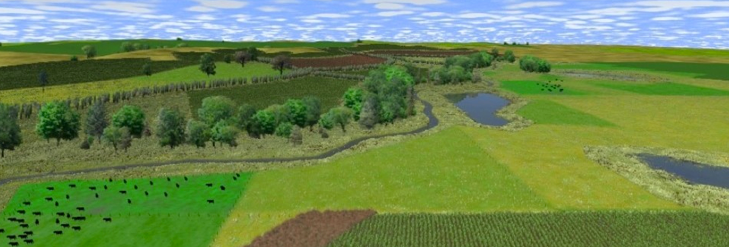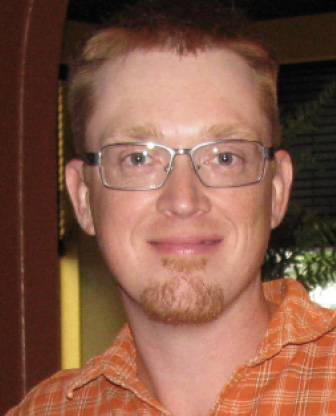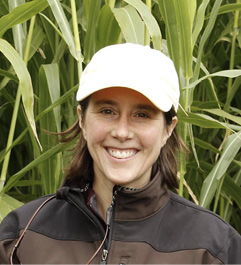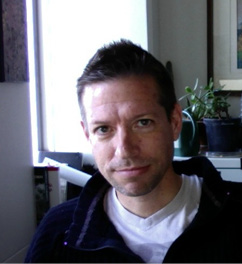This essay is based on Drake Larsen’s Master’s thesis at Iowa State University.
Twenty-five years from now, what will fertile agricult rural landscapes of today look like? What benefits will they provide to the people who rely on them? And, if people want something different, how might they craft the landscapes they prefer?
These were the questions that underlay the creation of the six photorealistic landscapes we share with you here. We used these images as a tool to enhance communication with diverse agricultural and environmental stakeholders about the management of rural Iowa. Previous studies have shown that visualization can be a useful tool for this kind of engagement; they help set a level playing field for discussion, whereby miscommunications commonly associated with complex information are minimized and divergent interpretations can be more openly conveyed. Additionally, such images can evoke deeper elements of human consciousness than words do alone.
The photorealistic landscape images combine art and science. They are similar to one another in that they all depict the same place: a hypothetical Iowa landscape, 66.4 hectares in size, and bisected by a stream. The environmental template for each half is typical of two of Iowa’s primary landforms: the Des Moines Lobe on the right and the Southern Iowa Driftplain on the left. Scenarios differ, however, in the amount of perennial vegetation depicted, with the percentage increasing according to a base-2 logarithmic scale (i.e., two percent, four percent, eight percent, 16 percent, 32 percent, and 64 percent perennial cover). Land management strategies portrayed were established by four natural resource professionals—an agronomist, an ecologist, an economist, and an engineer—in a single planning session facilitated by the lead author. The professionals prescribed management for each of six scenarios based on template topographic, soil, and hydrological conditions and potential perennial-based agricultural practices, including bioenergy plantings, constructed wetlands, prairie strips, rotational grazing, and variable-width riparian buffers. The images were created using Visual Nature Studio 3 (3d Nature, LLC) software.
Accompanying each of the photorealistic images are quotes representing the depth and diversity of responses from our interviewees. We gathered these quotes from structured, in-depth interviews with 37 stakeholders between June and December 2010. Participants were asked to sort the images from “the landscape that would provide the fewest to the greatest benefits.” The term “benefits” was intentionally undefined to allow participants the freedom to define topics without a large degree of influence or preface from the interviewer. Participants were then asked to list and describe the benefits they had in mind when performing the sort, and were asked to describe specific features that led them to believe these benefits were, or were not, being provided. The interview concluded with a question about balancing the output of agricultural products with other benefits.
Overall the interviews generated vivid and specific descriptions of expected benefits associated with agricultural landscapes, likely due in large part to the photo elicitation. Many individuals accepted the scenario images as a real place, and accordingly the responses became more personal in nature. This attachment suggests that the images allowed participants to start interviews “on the same page” and provided them a better understanding of some of the spatial and biophysical aspects of the scenarios, which would be difficult to convey in a text-based depiction alone. The benefits and associated values expressed by interviewees were always seen as being dependent on the specific ecological and socioeconomic context at hand.
The benefits from agriculture were commonly divided by participants into two general categories, environmental and economic, with many participants asking for clarification when prompted to provide benefits; “are you asking for environmental or economic benefits?” While the answer to that inquiry was consistently “any and all benefits to you,” given this distinction, the theme of economics took on a much greater role in some interviewees than others, as reflected in the accompanying quotes.
The number and type of benefits associated with each scenarios differed among individuals, and the aesthetic value of a place was dependent on an individual’s expectations for a landscape. For example, row-crop farmers expressed a higher number of benefits associated with landscapes with lower percentages of perennials and described them as pleasing; farmers with livestock generally voiced the opposite. Aesthetically pleasing landscapes that could provide recreation and tourism opportunities were frequently described as being an essential part of thriving rural communities and rural development.
Benefits related to water and soil were the most frequently mentioned and were highly favored by a wide range of stakeholders. Specific benefits included fresh drinking water, water bodies for recreation, habitat for aquatic wildlife, regulation of hydrology for flood mitigation, reduced water runoff, prevention of infield water erosion, maintenance of nutrient cycles, long-term maintenance of soil fertility, and carbon sequestration. Water was viewed as being most important for three reasons: 1) water was described as being essential for life; 2) water quality was described as being an indica tor of greater agroecosystem “health”, and 3) clean water was foundational to many other benefits (e.g., aesthetic and spiritual benefits, tourism and recreation, and livestock production).
We posit that agriculture worldwide is at a pivotal stage in terms of integrating 20th Century production norms with 21st Century societal demand for sustainability and enhanced quality of life. As the depth of commentary suggests, these images allowed us to have a broad conversation about agricultural land use and complex outcomes that otherwise couldn’t have happened: our discussion with stakeholders in Iowa went beyond food, feed, fiber, and fuel to include the additionally important topics of water, wildlife, and wonder. Which landscape do you prefer?
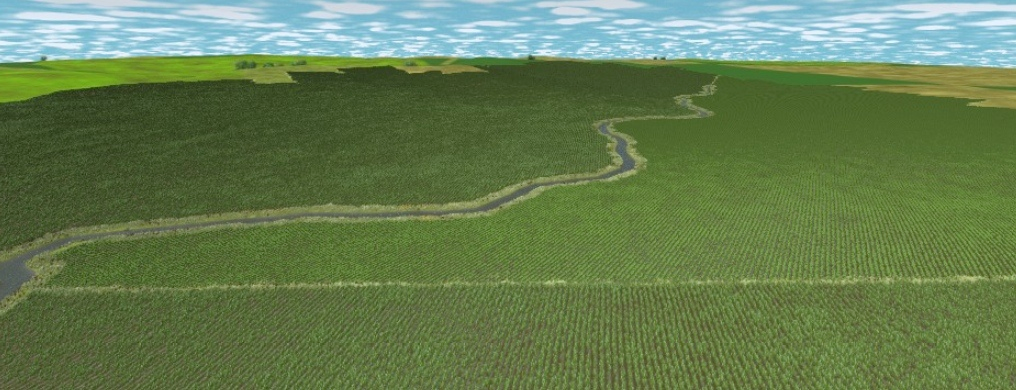
Image courtesy of Schulte
“I hate to say it but it is pretty much…there are no environmental benefits.”
“Unfortunately we tend to see more and more of this, 95-plus percent of the land is in agricultural production, this is what we see across the landscape in Iowa…we put a lot of demands on the resources here.”
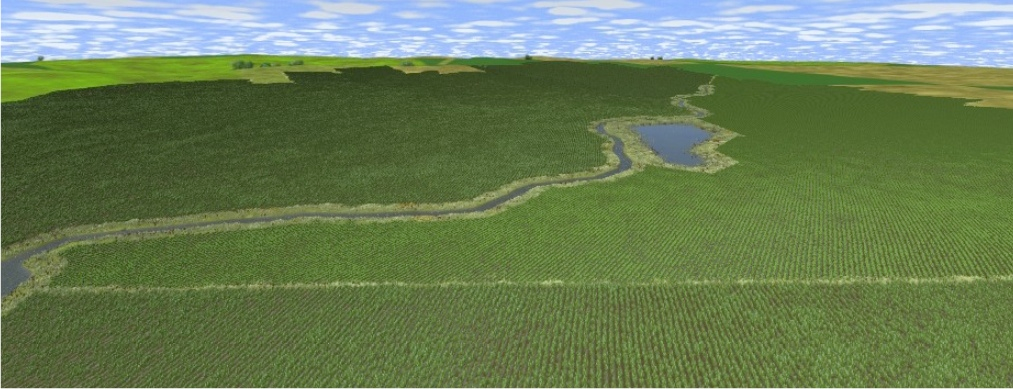
Image courtesy of Schulte
“I don’t consider this to be sustainable. Remember we have only been doing this corn bean rotation for the last 40 years or so, it hasn’t always been like that.”
“That is what we have today. And it is practical to farm. If there were terraces in that picture I would be happier.”

Image courtesy of Schulte
“The buffer strip is probably … and the wetland is, from an economist[’s] perspective, unproductive land. So unless you can generate some revenue off of that in some way…”
“I have read some of the research so I know where some of the numbers are, and the 10 percent is [what’s needed], if [perennial conservation practices] are targeted.”

Image courtesy of Schulte
“This would be best, with the tree and the buffer, [this] is far less intense now than what is going on in a lot of areas today. But it is still in pretty intense agriculture too…[this] would be the best.”
“This would probably be a compromise…it is in perennials but it is being used, because you got cattle, some place you will have hay land that is going to be cropped and things like that, so it’s not like it’s not productive agricultural land, it is just a different crop.”

Image courtesy of Schulte
“I prefer this one, fewer brush and trees. [This] is a landscape that has not been appreciated much in Iowa is the open country grassland landscape; grass and wildlife, and soil quality would be a better in this system. I think it is better soil tilth*, better soil quality. Those are the things I care about the most: soil, water and wildlife.”
*suitability for planting or growing a crop
“Not in my world, I am not a hunter or fisherman. I don’t take time to recreate…[I] would be cutting trees along the ditch here to get rid of them.”

Image courtesy of Schulte
“This is where I’d build my house.”
“Small plots, large amount of land that generates no revenue or is in crops that have over time. People have gone broke trying to do this, like cattle production.”
“I certainly see something like this in the future.”
“I might enjoy it, but it may not pay the mortgage.”
